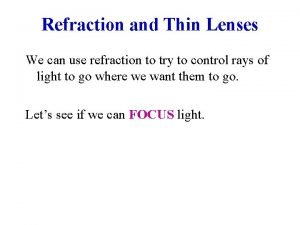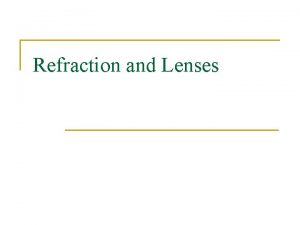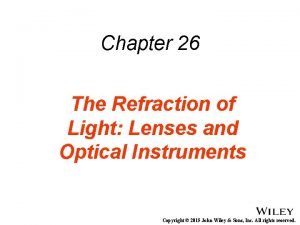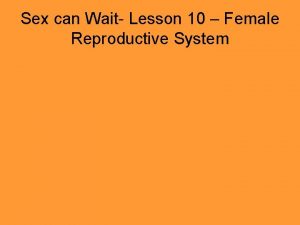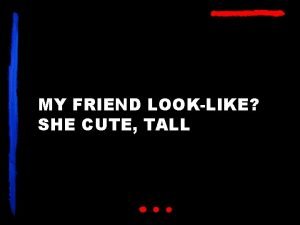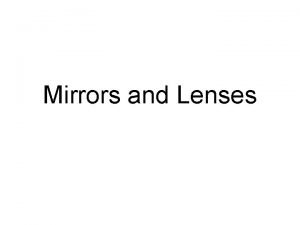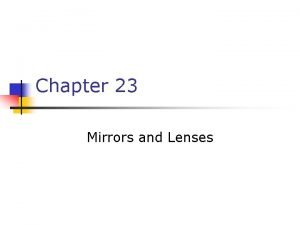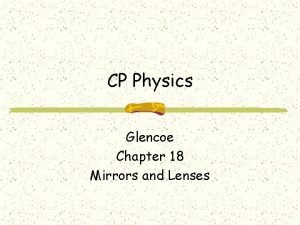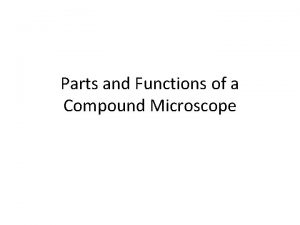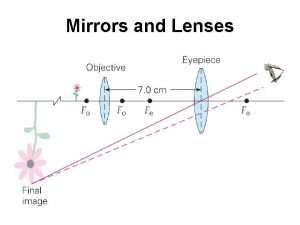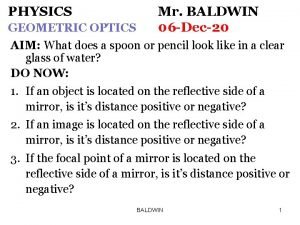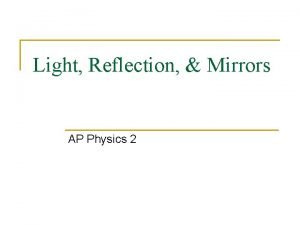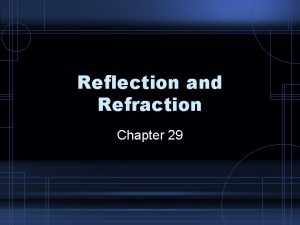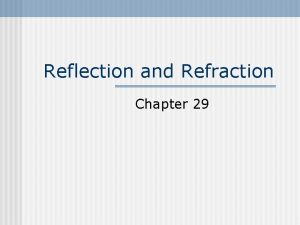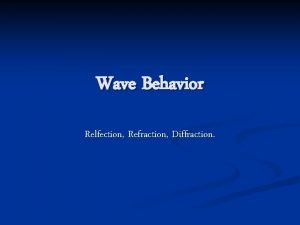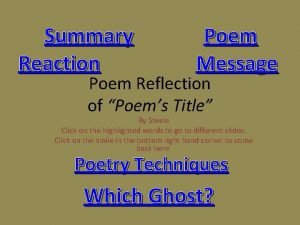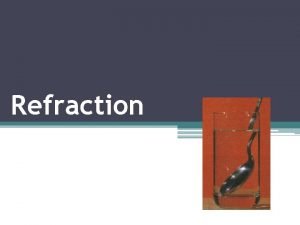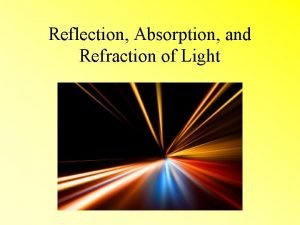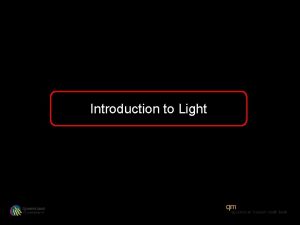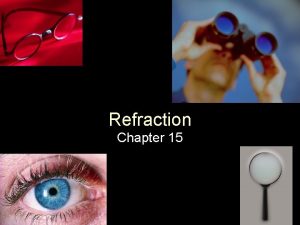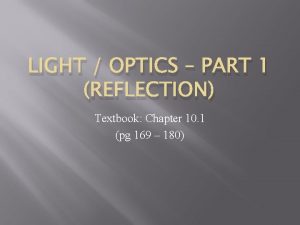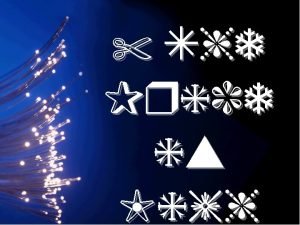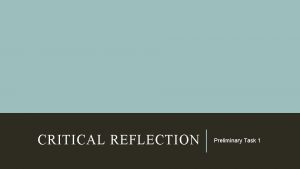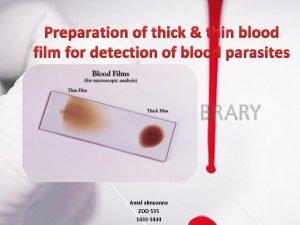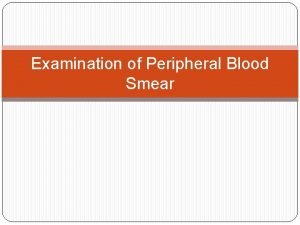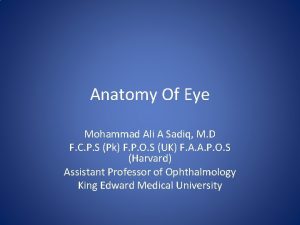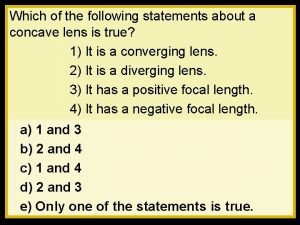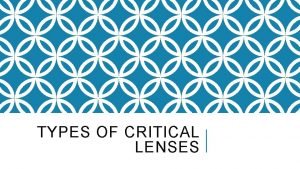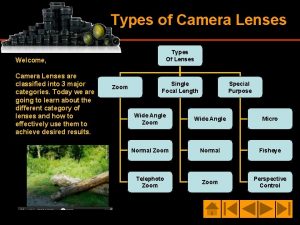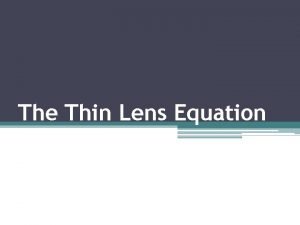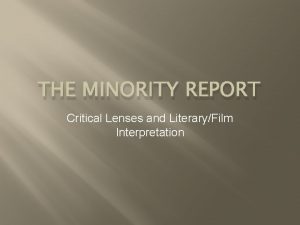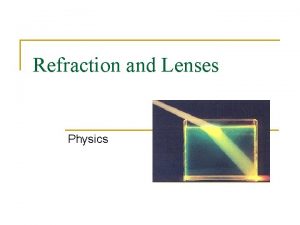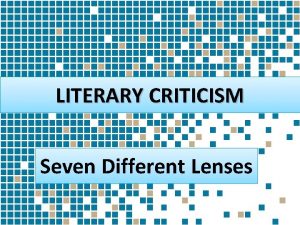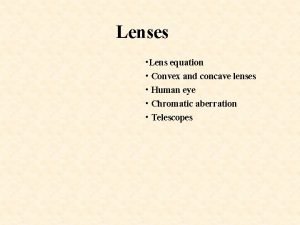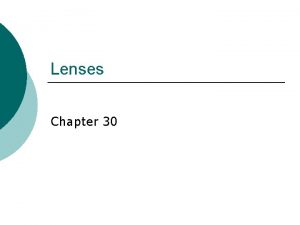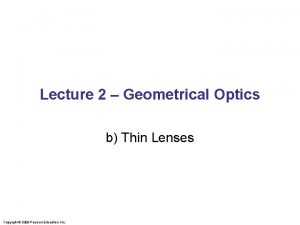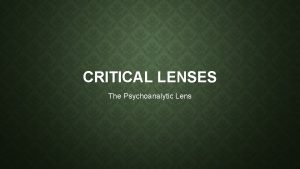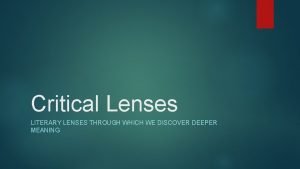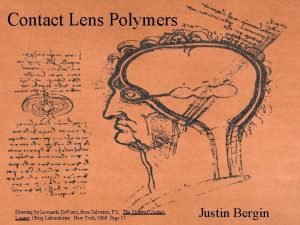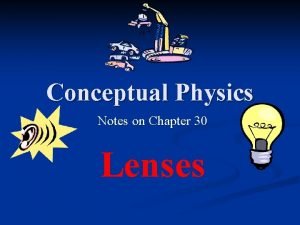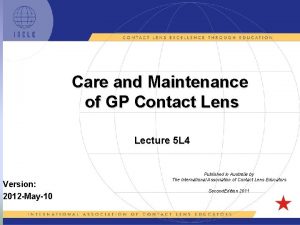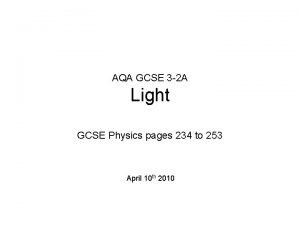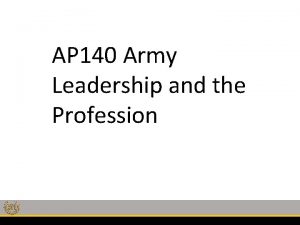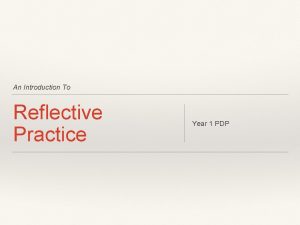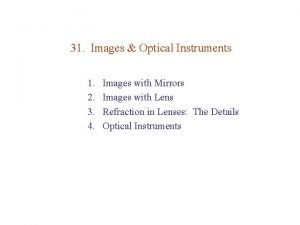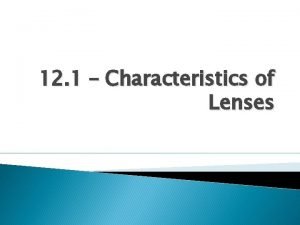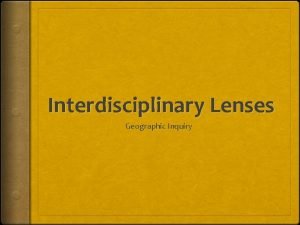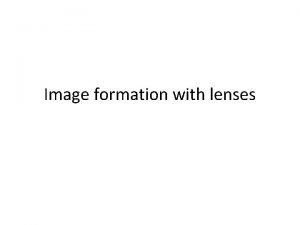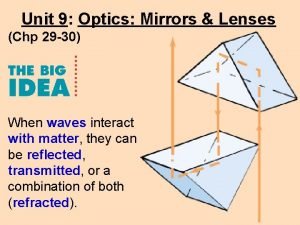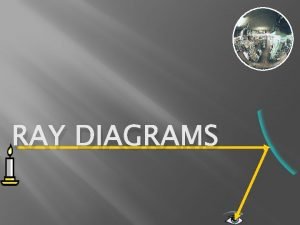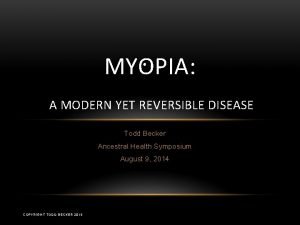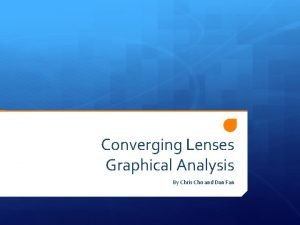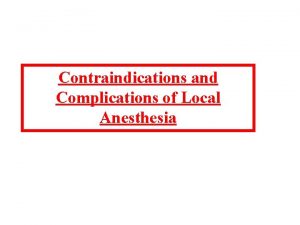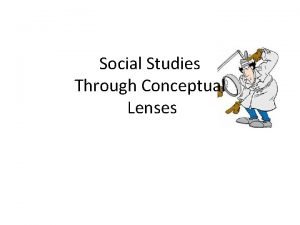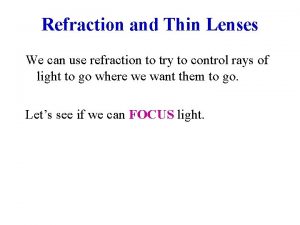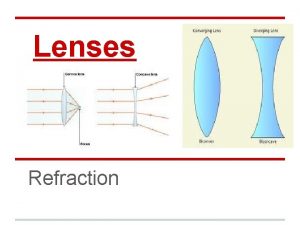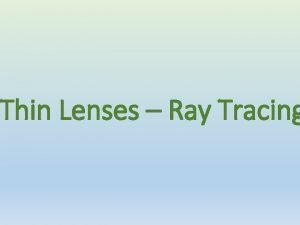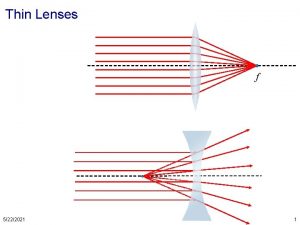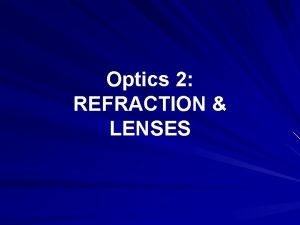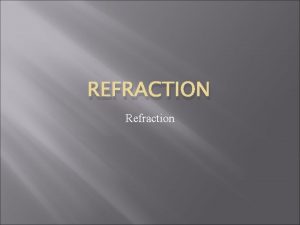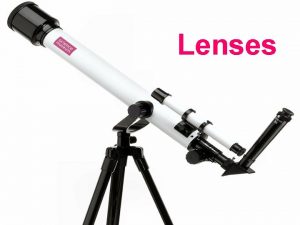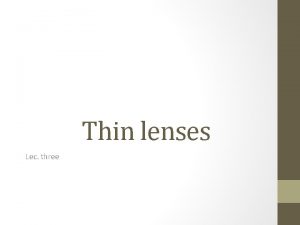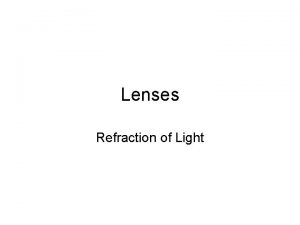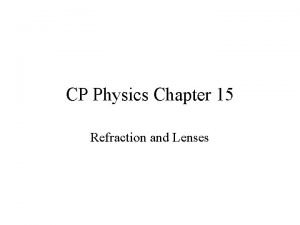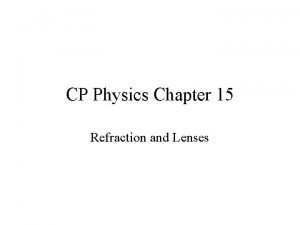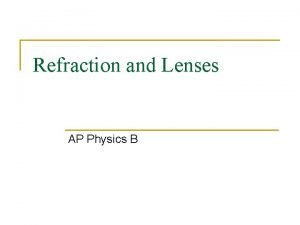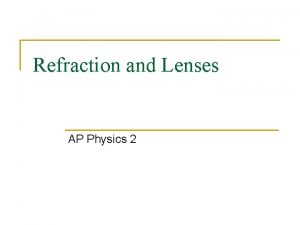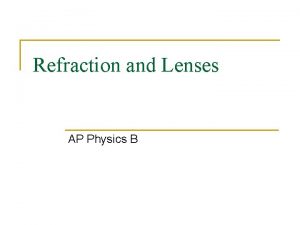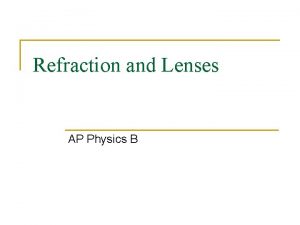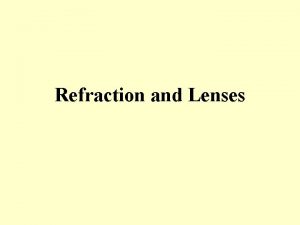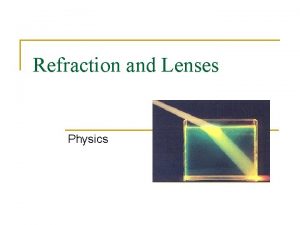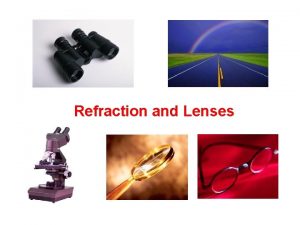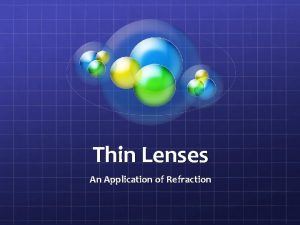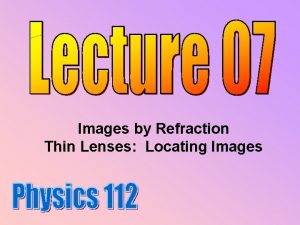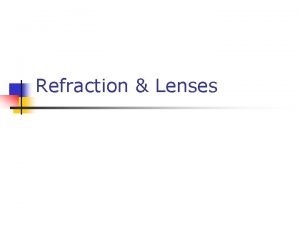Refraction and Thin Lenses We can use refraction










































































- Slides: 74

Refraction and Thin Lenses We can use refraction to try to control rays of light to go where we want them to go. Let’s see if we can FOCUS light.

Refraction and Thin Lenses What kind of shape do we need to focus light from a point source to a point? lens with some shape for front & back point source of light s’ = image distance s = object distance screen

Refraction and Thin Lenses Let’s try a simple (easy to make) shape: SPHERICAL. Play with the lens that is handed out Does it act like a magnifying glass?

Refraction and Thin Lenses Let’s try a simple (easy to make) shape: SPHERICAL. Play with the lens that is handed out Does it act like a magnifying glass? Does it focus light from the night light?

Refraction and Thin Lenses Let’s try a simple (easy to make) shape: SPHERICAL Play with the lens that is handed out Does it act like a magnifying glass? Does it focus light from the night light? Does the image distance depend on the shape of the lens? (trade with your neighbor to get a different shaped lens)

Refraction and Thin Lenses Spherical shape is specified by a radius. The smaller the sphere (smaller the radius), the more curved is the surface! R R R 2 R 1

Refraction and Thin Lenses In the computer assignment Thin Lenses (Vol. 5, #2), in the Introduction, the following relation is derived if we make a couple of assumptions: n is the index of refraction (n≡c/v), R 1 and R 2 are the radii of curvature of the lens; s is the object distance (from object to lens) and s’ is the image distance (from lens to screen). Assumptions: THIN lenses & SMALL ANGLES

Refraction and Thin Lenses This is called the THIN LENS equation: NOTE: – all the parameters on the left (n, R 1, R 2) refer to how the lens is MADE; – all the parameters on the right (s, s’) refer to how the lens is USED.

Refraction and Thin Lenses Therefore, we break the THIN LENS equation: (nglass – nair) 1 1 *{ + } = + nair R 1 R 2 s s’ Into the LENS MAKERS equation and the LENS USERS equation: (nglass – nair) 1 1 1 *{ + }= & = + nair R 1 R 2 f f s s’ where f is a distance called the focal length.

Refraction and the Lensmakers Eq. Note that the order of R 1 and R 2 does NOT matter - which means that it doesn’t matter which side of the lens is front and which is back.

Refraction and the Lensmakers Eq. QUESTION: Can the focal length, f, be negative?

Refraction and the Lensmakers Eq. Can the focal length, f, be negative? Can the radii, R 1 & R 2, be negative?

R 1>0 R 2>0 The NORMAL (convex) lens above is considered to have R 1 and R 2 both positive, and so f must be positive.

R 1<0 R 2<0 This (concave) lens is considered to have R 1 and R 2 both negative, and so f must be negative!

Refraction and the Lensmakers Eq. What about these two shapes? Is f positive or negative? HINT: which radius in each case is bigger?

• LEFT: |R 1| < |R 2|, R 1 wins, R 1>0 so f>0 (lens is thicker in middle) • RIGHT: |R 1| > |R 2|, R 2 wins, R 2<0 so f<0 (lens is thinner in middle)

Negative focal lengths Positive focal length lenses focus light – that is, they bend the rays so that the rays tend to converge. Negative focal length lenses tend to make the light diverge rather than converge. Often a negative focal length lens is used when one lens converges the light too much – the negative lens then makes the light converge less quickly. The same formulas work for negative lenses as for positive lenses. We just have to be careful with the signs of s and s’. The computer homework on Thin Lenses talks about negative focal length lenses and one of their uses: in eye glasses.

Designing Lenses If we specify the focal length for a lens, then we have three parameters to specify: nglass, R 1, and R 2. Our design will entail choosing one of the two possible designs: for positive lenses either or. For the first case, , we could make the choice of R 1 = R 2= R. This simplifies the above equation to become: . For the second case, , R 1>0 and R 2<0, we need to be careful. We can’t choose |R 1| = |R 2 | since this will give 1/f = 0. We also have to make sure that |R 1| < |R 2 | to keep our shape.

Designing Lenses For negative lenses, we again have two choices for shapes similar to the choices for positive lenses. For the first case, )( R 1<0 and R 2<0, we could make the choice of R 1 = R 2= R. This simplifies the above equation to become: , where both f and R are negative. For the second case, ( R 1>0 and R 2<0, we again need to be careful. We can’t choose |R 1| = |R 2 | since this will give 1/f = 0. In this case, have to make sure that |R 1| > |R 2 | to keep our shape.

Designing Lenses: Example + If we are to design a lens to have a positive focal length of 30 mm, then we can use the symmetrical design so that R 1=R 2=R. We need to choose one more parameter, so we can solve for the remaining one. Let’s choose nglass = 1. 67. Our equation now becomes: {(1. 67 – 1)/1}*(2/R) = 1/(30 mm). We can solve this for R: R = (30 mm)*(0. 67)*2 = 40. 2 mm.

Designing Lenses: Example Let’s now choose a harder example: that of a negative focal length contact lens, (. Here we want R 1>0 and R 2<0, and we want |R 1| > |R 2 |. Let’s say we want a focal length of -55 mm, and we choose a clear plastic of index of refraction 1. 67. We need to choose either R 1 or R 2. Let’s choose R 2 = -100 mm. Our equation becomes: (1. 67 – 1)*{1/R 1 + 1/(-100 mm)} = 1/(-55 mm) , or (. 67)/R 1 – (. 0067/mm) = -. 0182/mm, or (. 67)/R 1 = -. 0115/mm, or R 1/(. 67) = - 1 mm/. 0115 , or R 1 = -. 67 mm/. 0115 = -58. 35 mm. But this can’t work since we wanted R 1>0 for a contact lens design. We need to choose |R 2| to be a smaller number (<. 67* |f|) so that R 1 can be positive. If we choose R 2 = -30 mm, then we get R 1 = 161. 4 mm.

Refraction and the Lens-users Eq. f>0 s > 0 AND s > f s’ > 0 AND s’ > f f f s s’ Example: 1 / 5 cm = 1 / 10 cm + 1 / 10 cm

Refraction and the Lens-users Eq. as s gets bigger, s’ gets smaller (but still need s’ > f) f f s s’ Example: 1 / 5 cm = 1 / 30 cm + 1 / 6 cm

Refraction and the Lens-users Eq. as s approaches infinity s’ approaches f f f s s’ Example: 1 / 5 cm = 1 / 200 cm + 1 / 5. 128 cm

Refraction and the Lens-users Eq. f>0 s > 0 AND s > f s’ > 0 AND s’ > f f f s s’ Example: 1 / 5 cm = 1 / 10 cm + 1 / 10 cm

Refraction and the Lens-users Eq. as s gets smaller, s’ gets larger f f s s’ Example: 1 / 5 cm = 1 / 6 cm + 1 / 30 cm

Refraction and the Lens-users Eq. as s approaches f, s’ approaches infinity f f s s’ Example: 1 / 5 cm = 1 / 5. 1 cm + 1 / 255 cm

Refraction and the Lens-users Eq. Before we see what happens when s gets smaller than f, let’s use what we already know to see how the lens will work.

Refraction and the Lens-users Eq. Any ray that goes through the focal point on its way to the lens, will come out parallel to the optical axis. (ray 1) f f ray 1

Refraction and the Lens-users Eq. Any ray that goes through the focal point on its way from the lens, must go into the lens parallel to the optical axis. (ray 2) f f ray 1 ray 2

Refraction and the Lens-users Eq. Any ray that goes through the center of the lens must go essentially undeflected. (ray 3) Note that all three rays when viewed from the right look like they come from the same location – the image location. object image f f ray 1 ray 3 ray 2

Refraction and the Lens-users Eq. Note that a real image is formed. A real image is one where the light rays do pass through the image location (unlike the case of a mirror) Note that the image is up-side-down. object image f f ray 1 ray 3 ray 2

Refraction and the Lens-users Eq. – By definition, magnification: M ≡ h’/h. – By looking at ray 3 alone, we can see by similar triangles (h/s = h’/s’) that M ≡ h’/h = -s’/s. Note that M has no units. We usually indicate the magnification with an X. object h s’ s f f image h’<0 note h’ is up-side-down and so h’ < 0 ray 3

Refraction and the Lens-users Eq. This is the situation when the lens is used in a camera or a projector. Image is REAL. Real image has the rays of light actually passing through the image, unlike the virtual image we found in the case of a mirror. object image f f ray 1 ray 3 ray 2

Refraction and the Lens-users Eq. What happens when the object distance, s, changes? object h s f s’ image f h’ ray 1 ray 3 ray 2

Refraction and the Lens-users Eq. M ≡ h’/h = -s’/s Notice that as s gets bigger, s’ gets closer to f and |h’| gets smaller. object s’ h s f f h’ image ray 1 ray 3 ray 2

Focusing To focus a camera, we need to change s’ as s changes. To focus a projector, we need to change s as s’ changes. We do this by screwing the lens closer or further from the film (image) or slide (object). But what about the eye? How do we focus on objects that are close and then further away with our eyes? Do we screw our eyes in and out like the lens on a camera or projector?

Focusing But what about the eye? How do we focus on objects that are close and then further away with our eyes? Do we screw our eyes in and out like the lens on a camera or projector? - NO, instead our eyes CHANGE SHAPE and hence change f as s changes, keeping s’ the same!

Refraction and the Lens-users Eq. Let’s now look at the situation where s < f (but s is still positive): f s f Example: 1 / 5 cm = 1 / 4 cm + 1 / s’

Refraction and the Lens-users Eq. We can still use our three rays. Ray one if extended backwards goes through the focal point on the left side. ray 1 f s f

Refraction and the Lens-users Eq. Ray two goes through the focal point on the right side (and parallel to the axis on the left). ray 1 f s f ray 2

Refraction and the Lens-users Eq. Ray three goes through the center of the lens essentially undeflected. When viewed from the right side, all three rays appear to come from h’ located at s’. ray 1 h’ f s s’ f ray 2 ray 3

Refraction and the Lens-users Eq. Notice that: s’ is on the “wrong” side, which means that s’ < 0 , and that |s’| > |s| so f > 0. ray 1 h’ f s s’ f ray 2 ray 3 Example: 1 / 5 cm = 1 / 4 cm + 1 / -20 cm

Refraction and the Lens-users Eq. Notice that: h’ is right-side-up and so h’ > 0, M ≡ h’/h = -s’/s so M > 0 (s’ < 0 but -s’ > 0). h’ f s s’ f Example: 1/5 cm = 1/4 cm + 1/(-20 cm) M = -s’/s = -(-20 cm)/4 cm = 5 X. ray 3

Refraction and the Lens-users Eq. This is the situation when the lens is used as a magnifying glass! Image is VIRTUAL. The rays only appear to come from the image, they don’t actually pass through the location of the image just like a mirror ray 1 h’ f s s’ f ray 2 ray 3

Refraction and the Lens-users Eq. The same lens can be used as: • a camera lens: s >> f, s > s’, M < 0, |M| < 1 • a projector lens: s > f, s’ > s, M < 0, |M| > 1 • a magnifying glass: s < f, s’ < 0, M > 1

Refraction and the Lens-users Eq. Notes on using a lens as a magnifying glass: • hold lens very near your eye • want IMAGE at best viewing distance which has the nominal value of 25 cm so that s’ = -25 cm.

Refraction and the Lens-users Eq. Are there any limits to the magnifying power we can get from a magnifying glass?

Refraction and the Lens-users Eq. Are there any limits to the magnifying power we can get from a magnifying glass? – Recall: 1/s + 1/s’ = 1/f and M = -s’/s where s’ = -25 cm. – For biggest M, need smallest s which means smallest f.

Refraction and the Lens-users Eq. For biggest M, need smallest s which means smallest f. Recall lensmakers eq: • For smallest f, need smallest R’s. • But smallest R’s mean very small size!

Refraction and the Lens-users Eq. • Magnifying glass has limits due to size • As we will see in a little bit, magnifying glass also has limits due to resolving ability • NEED MICROSCOPE (two lens system)

Systems of Two Lenses Before we go to the microscope, let’s consider putting two lenses in a system. The basic idea is that the image of the first lens becomes the object for the second lens. We (will see / have seen) in lab how this works with two lenses. This also works if we consider the eye to have a lens and eyeglasses to be a second lens.

Can s, the object distance, be negative? So far, we have looked at s>f and s<f, but s was always positive. Can s be negative? If we have a converging lens (such as the eye) forming an image, and we place a diverging lens in front of the converging lens, between the location where the converging lens is and its image, then the image of the first converging lens, which is the object for the second diverging lens, is on the “wrong” side of the diverging lens, and hence s for the diverging lens is negative. See the next slide for a diagram.

Can s, the object distance, be negative? The pink lines indicate the path of converging diverging the light without the diverging lens The converging lens by itself would focus the image closer. Object First image The diverging lens has as its object the first image of the converging lens which is on the wrong side of the diverging lens and so is negative, but the final image is on the correct, positive, side of the diverging lens. Final image

Near Sighted A near sighted person can see things clearly if they are close, but has trouble focusing on things far away. When things are close, the eye has to bend the light a lot in order to focus, and the near sighted person’s eyes can do that. When things are far away, the eye doesn’t have to bend the light as much, but the near sighted person’s eyes have trouble with this. What we want is a lens that will take a real object that is far away and make an image that is closer (but still on the same side of the lens). The eye can then focus on this (closer) image. object image for lens becomes object for eye lens eye

2 Lenses – Near Sighted The pink dotted lines indicate the path of diverging the light without the diverging lens in place. lens The blue/grey dotted lines indicate where the virtual image of the diverging lens appears to be. lens of the eye Object image A near sighted person has a lens in the eye that bends the light too much and so needs eyeglasses to increase the angle of incoming light so that the eye can bend it so that it focuses on the retinal cells

Near Sighted In this case, the object distance is positive and somewhat large, while the image distance is negative (on the opposite side of where it normally would be) and smaller than the object distance. This image of the lens becomes the object for the eye, and it is close enough for the near sighted person to focus on. So when we use thin lens equation, 1/f = 1/s + 1/s’, we find that we need a negative focal length lens to correct for nearsightedness. object distance > 0 object image distance < 0 image for lens eye becomes object for eye object distance for eye

Far Sighted A far sighted person can see things clearly if they are far away, but has trouble focusing on things close. When things are close, the eye has to bend the light a lot in order to focus, and the far sighted person’s eyes have trouble with that. When things are far away, the eye doesn’t have to bend the light as much, and the far sighted person’s eyes can do this. What we want is a lens that will take a real object that is near and make an image that is further away (but still on the same side of the lens). The eye can then focus on this (further away) image for lens becomes object for eye object lens eye

Far Sighted In this case, the object distance is positive and somewhat small, while the image distance is negative (on the opposite side of where it normally would be) and larger than the object distance. This image of the lens becomes the object for the eye, and it is far enough away for the far sighted person to focus on. So when we use thin lens equation, 1/f = 1/s + 1/s’, we find that we need a positive focal length lens to correct for farsightedness. image distance < 0 object distance > 0 image for lens object becomes object for eye object distance for eye lens eye

Far sighted The pink dotted lines indicate converging eye the path of the light without the lens converging lens. They converge Retinal behind the retina. cells Object The lens of the eye does not bend the light enough so it needs the help of a converging lens to bend the light so that it focuses on the retinal cells. Image location without converging lens

Microscope • Use first lens (the objective lens) to form an image (use as a projector lens) Since we are using the objective lens as a projector, we need so > fo, and since we want a bigger image, we want so’ > so. so so’ objective lens fo Objectobjective Imageobjective

Microscope • Use second lens (eyepiece) as a magnifying glass to magnify Imageobjective Since we are using the second lens, the eyepiece, as a magnifying lens, we need se < fe and we want se’ = -25 cm. so objective lens so’ se eyepiece se ’ fo Objectobjective Imageeyepiece fe Imageobjective Objecteyepiece eye

Microscope The image from the eyepiece becomes the object for the eye. Mo = -so’/so Me = -se’/se Mtotal = Mo * Me = (so’*se’) / (so*se) L is the distance between the two lenses. so objective lens so’ L = so’ + se se eyepiece se ’ 1/so + 1/so’ = 1/fo 1/se + 1/se’ = 1/fe fo Objectobj Imageeyepiece Objecteye fe Imageobj Objecteyepiece eye NOTE: se’ = -25 cm so Mtotal < 0 ! Final image is upside down

Microscope • DESIGN: 8 quantities: – s 1, s 1’, s 2’, f 1, f 2, L, M • DESIGN: 4 equations: – two thin lens equations – equation for L – equation for M • Usually know s 2’ = -25 cm and M • Get to choose two others

Example of designing a microscope Design a microscope with a magnification of 100. We have four equations: 1/fobj = 1/s 1 + 1/s 1’ , 1/feye = 1/s 2 + 1/s 2’, L = s 1’ + s 2 , and M = (s 1’/s 1)*(s 2’/s 2). We have eight parameters: s 1, s 1’, s 2’, fobj, feye, L, and M. We are given (or know) two of these: M = -100, and s 2’ = -25 cm.

Example of designing a microscope Note that the diagram for the microscope is on a previous slide that we repeat on the next slide. Since we have four equations and six unknowns, we need to choose two of the six unknowns. However, we must make sure that only the Magnification, M, and the final image distance, s 2’, are negative, and that the remaining six parameters are all positive.

Microscope Diagram Mo = -so’/so Me = -se’/se Mtotal = Mo * Me = (so’*se’) / (so*se) so so’ objective lens L = s o’ + s e se eyepiece se ’ 1/so + 1/so’ = 1/fo 1/se + 1/se’ = 1/fe fo Objectobj Imageeyepiece Objecteye fe Imageobj Objecteyepiece eye NOTE: se’ = -25 cm so Mtotal < 0 !

Example of designing a microscope At this point, let’s fill in the knowns into the four equations: 1/fo = 1/so + 1/so’, 1/fe = 1/se + 1/se’, or 1/fe = 1/se + 1/(-25 cm) L = so’ + se , and M = (so’/so)*(se’/se), or -100 = (so’/so)*(-25 cm/se). There are many ways to choose two unknowns. We could choose the two focal lengths, fo and fe. We could choose the length and the focal length of the objective, L and fo. For this example, I’m going to choose L and so since I want a reasonable length for the microscope and I want a small distance for the slide to be from the objective lens.

Example of designing a microscope To be specific, let me specify: L = 30 cm, and so = 1 cm. The equations now become: 1/fo = 1/1 cm + 1/so’ 1/fe = 1/se + 1/(-25 cm) 30 cm = so’ + se , and -100 = (so’/1 cm )*(-25 cm/se). Notice that this particular choice left all four equations with at least two unknowns in each equation. This is not a nice situation for doing the algebra, although it is certainly possible. Let’s try a different set of choices.

Example of designing a microscope To be specific, let me specify L and s 2. There is an advantage in specifying s 2 in that this gives you a chance of evening out the magnifications due to the two lenses. If we split the magnification between the two lenses, each magnification should provide SQRT{M}. In this case, Meye should be about SQRT{M} = SQRT{100} = 10. With Meye = 10 = -s 2’/s 2 = --25 cm / s 2 = 10, we would choose s 2 to be 2. 5 cm L = 30 cm, and s 2 = 2. 5 cm. The equations now become: 1/fobj = 1/s 1+ 1/s 1’ 1/feye = 1/(2. 5 cm) + 1/(-25 cm) 30 cm = s 1’ + 2. 5 cm , and -100 = (s 1’/s 1)*(-25 cm/2. 5 cm). Note that this choice gives us two of the equations with only one unknown: the second and third equations.

Example of designing a microscope 1/fobj = 1/s 1+ 1/s 1’ 1/feye = 1/(2. 5 cm) + 1/(-25 cm) 30 cm = s 1’ + 2. 5 cm , and -100 = (s 1’/s 1)*(-25 cm/2. 5 cm). From the second equation, 1/feye = 1/(2. 5 cm) + 1/(-25 cm) feye = 2. 778 cm. From the third equation, 30 cm = s 1’ + 2. 5 cm s 1’ = 27. 5 cm. We now put these values into our remaining two equations.

Example of designing a microscope 1/fobj = 1/s 1+ 1/(27. 5 cm) 1/(2. 778 cm) = 1/(2. 5 cm) + 1/(-25 cm) 30 cm = 27. 5 cm + 2. 5 cm , and -100 = (27. 5 cm/s 1)*(-25 cm/2. 5 cm). Although the first equation has two unknowns, the fourth equation only has one, so we can solve for s 1: -100 = (27. 5 cm/s 1)*(-25 cm/2. 5 cm), or s 1 = 2. 75 cm. Now we can substitute this value into the first equation and solve for our last unknown, fobj.

Example of designing a microscope 1/fobj = 1/(2. 75 cm)+ 1/(27. 5 cm) 1/(2. 778 cm) = 1/(2. 5 cm) + 1/(-25 cm) 30 cm = 27. 5 cm + 2. 5 cm , and -100 = (27. 5 cm/2. 75 cm)*(-25 cm/2. 5 cm). Solving the top equation for fobj gives fobj = 2. 5 cm. A solution to this design problem then is: M = -100 L = 30 cm fobj = 2. 75 cm s 1’ = 27. 5 cm feye = 2. 778 cm s 2 = 2. 5 cm s 2’ = -25 cm

Using a lens: • • • Camera: focus by changes s’ Projector: focus by changing s eye: focus by changing f (shape) magnifying lens focus by changing s’ what about seeing underwater?
 What kind of shape is this?
What kind of shape is this? Refraction by a lens
Refraction by a lens Refraction of light in lenses
Refraction of light in lenses Sex can wait thin your paint
Sex can wait thin your paint My friend and i am tall and thin
My friend and i am tall and thin Who are they
Who are they Mirrors and lenses
Mirrors and lenses Sign convention of mirror
Sign convention of mirror Physics classroom lenses and mirrors
Physics classroom lenses and mirrors Dust shield of microscope
Dust shield of microscope Types of mirrors and lenses
Types of mirrors and lenses Site:slidetodoc.com
Site:slidetodoc.com Ap physics 2 mirrors and lenses
Ap physics 2 mirrors and lenses How you use ict today and how you will use it tomorrow
How you use ict today and how you will use it tomorrow Rainbow total internal reflection
Rainbow total internal reflection Refraction of sound
Refraction of sound Reflection wave behavior
Reflection wave behavior Poem reaction
Poem reaction Partial reflection and refraction examples
Partial reflection and refraction examples Reflection refraction transmission and absorption of light
Reflection refraction transmission and absorption of light Light energy bill nye
Light energy bill nye Invictus by william ernest henley
Invictus by william ernest henley Introduction of light reflection and refraction
Introduction of light reflection and refraction Raindrops sunlight and refraction lyrics
Raindrops sunlight and refraction lyrics Bill nye reflection and refraction
Bill nye reflection and refraction Reflection and refraction venn diagram
Reflection and refraction venn diagram Venn diagram of heat and electricity
Venn diagram of heat and electricity Bill nye reflection and refraction
Bill nye reflection and refraction Learning task 1 reflection and refraction
Learning task 1 reflection and refraction Look at the pictures and complete with can or can't
Look at the pictures and complete with can or can't The rate of weathering depends upon the area's ____.
The rate of weathering depends upon the area's ____. Thick and thin malaria smear
Thick and thin malaria smear Stratum granulosum
Stratum granulosum Thick and thin blood film
Thick and thin blood film University of pecs faculty of health sciences
University of pecs faculty of health sciences Peripheral smear report format
Peripheral smear report format Thick and thin questions anchor chart
Thick and thin questions anchor chart How thin and sharp is the moon tonight
How thin and sharp is the moon tonight Pars plicata
Pars plicata Fat and thin
Fat and thin Ulsi (ultra large scale integration)
Ulsi (ultra large scale integration) She is short and slim
She is short and slim Which of the following statement about lenses is correct?
Which of the following statement about lenses is correct? Critical lens definition
Critical lens definition What are the different types of camera lenses
What are the different types of camera lenses Optics equation
Optics equation Lenses in literature
Lenses in literature Types of lenses physics
Types of lenses physics Types of literary criticism
Types of literary criticism Owl literary criticism
Owl literary criticism Concave convex lens simulation
Concave convex lens simulation Chapter 30 lenses
Chapter 30 lenses Magnification formula for lenses
Magnification formula for lenses Traditional literary criticism ppt
Traditional literary criticism ppt Army ethical reasoning model
Army ethical reasoning model Psychoanalytic lense
Psychoanalytic lense What are critical lenses
What are critical lenses 6 literary lenses
6 literary lenses Contact lens drawing
Contact lens drawing Chapter 30 conceptual physics
Chapter 30 conceptual physics Optikem international
Optikem international Ray diagram bbc bitesize
Ray diagram bbc bitesize Ethical climate assessment survey army
Ethical climate assessment survey army Brookfields lenses reflective model
Brookfields lenses reflective model Sign convention for lenses in tabular form
Sign convention for lenses in tabular form Lenses characteristics
Lenses characteristics Interdisciplinary lenses
Interdisciplinary lenses The principle involved in the image formation by lenses
The principle involved in the image formation by lenses Refraction of light
Refraction of light Bionic contact lens university of washington
Bionic contact lens university of washington Diverging lens example
Diverging lens example Active focusing myopia
Active focusing myopia Lenses graph analysis
Lenses graph analysis Asanb
Asanb 5 lenses of social studies
5 lenses of social studies
